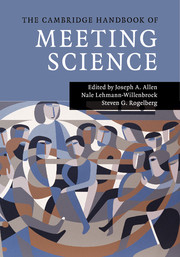Book contents
- The Cambridge Handbook of Meeting Science
- The Cambridge Handbook of Meeting Science
- Copyright page
- Dedication
- Contents
- Tables
- Figures
- Contributors
- Book part
- Part I Introduction
- Part II Premeeting Activities and Context
- Meeting Setup
- Meeting Composition
- Premeeting Communication
- Macro Meeting Context
- Part III The Meeting Itself
- Part IV Special Types of Meetings
- Part V Synthesis and Conclusion
- Book part
- Author Index
- Subject Index
- References
Macro Meeting Context
from Part II - Premeeting Activities and Context
Published online by Cambridge University Press: 05 August 2015
- The Cambridge Handbook of Meeting Science
- The Cambridge Handbook of Meeting Science
- Copyright page
- Dedication
- Contents
- Tables
- Figures
- Contributors
- Book part
- Part I Introduction
- Part II Premeeting Activities and Context
- Meeting Setup
- Meeting Composition
- Premeeting Communication
- Macro Meeting Context
- Part III The Meeting Itself
- Part IV Special Types of Meetings
- Part V Synthesis and Conclusion
- Book part
- Author Index
- Subject Index
- References
Summary
Previous research on work meetings has mainly been conducted in the Anglo-Saxon context. In this chapter, we add an international perspective that addresses this question: Does the national context of the meeting influence how it is structured and perceived? We provide a descriptive-comparative empirical analysis of differences and commonalities in both structural (i.e., size, length, frequency, lateness, the use of an agenda, and action points) and psychological (i.e., participation, satisfaction, and mood) meeting characteristics. Our analysis is based on a survey study with 710 participants from 45 countries. We first provide a comparison using a framework that classifies cultures according to the dimensions of space, time, and context using seven country clusters identified in the GLOBE study: Anglo (n = 91), Confucian Asia (n = 94), Eastern Europe (n = 242), Germanic Europe (n = 136), Latin Europe (n = 37), Middle East (n = 33), and Northern Europe (n = 70). We found important similarities, but also noteworthy differences in work meetings between locations. We discuss the emerging profile of cross-cultural meeting similarities and differences in light of their theoretical and managerial implications and provide ideas for future research on meetings across cultures.
- Type
- Chapter
- Information
- The Cambridge Handbook of Meeting Science , pp. 175 - 176Publisher: Cambridge University PressPrint publication year: 2015

